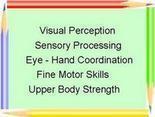-
 Handwriting Skills
Handwriting Skills
The Basic Skills
-

Handwriting skill depends on many other skills: upper extremity and trunk strength, endurance, bilateral coordination, motor planning, visual perception, eye-hand coordination, good sensory processing, fine motor skills and good attention.
Pencil and Crayon Grasp
-

PENCIL GRASP - the most efficient pencil grasp uses 3 fingers. The pencil is held between the tips of the thumb and index finger, and against the middle finger. CHILDREN DO NOT AUTOMATICALLY USE A 3 FINGER GRASP -IT NEEDS TO BE TAUGHT AND REINFORCED. Remember that fine motor activities that encourage 2 or 3 finger grasps will help develop a good pencil grasp! Look under Fine Motor Activities for specific suggestions.
Learning the Letters
-

Children should be taught how to form letters, regardless of style, and reinforced with practice under a watchful eye, otherwise incorrect formations may be learned. ONCE A CHILD LEARNS AN INCORRECT LETTER FORMATION IT IS EXTREMELY DIFFICULT TO UNDO! There are many types of handwriting practice books available in stores for home practice, but be sure to choose the same style your child uses in school.
Pre-Writing Skills
-

PRE-WRITING SKILLS - Drawing vertical, horizontal, diagonal lines as well as shapes are prewriting skills. CHILDREN SHOULD BE ABLE TO COPY 9 BASIC SHAPES WHICH ARE: VERTICAL AND HORIZONTAL LINES, A CROSS, LEFT AND RIGHT DIAGONALS, AN "X", CIRCLE, SQUARE, AND TRIANGLE. Coloring activities also help to build the ability to control the writing tool and change directions with it. ENCOURAGE DRAWING AND WRITING WITH OTHER MATERIALS : CHALK, PAINT, WITH WATER, IN SAND, ETC. ACTIVITY BOOKS WITH MAZES, DOT TO DOTS, ETC. ALSO HELP BUILD SKILLS. Manipulative activities such as wind-up toys and squeeze toys.
Finger Placement on Pencil
-

Children will often hold the pencil or crayon close to the point, which prevents them from seeing what they are writing. To help teach where to properly place the fingers on the pencil/crayon, mark the spot about 1 inch up from the point with a line or rubber band. Remember as the pencil gets sharpened this line will need to be redone. Some children may benefit from the use of a pencil grip on the pencil to help position the fingers correctly.
Handwriting Paper
-

Use primary paper when learning to print. This is 1 inch wide ruled paper with middle markers. THE MIDDLE MARKERS HELP WITH LEARNING LETTER SIZES. When this is successful, you can move to 3rd grade paper with middle markers. A student should be consistent with good letter size and formation BEFORE moving to composition paper (without middle markers). Keeping the type of paper (middle marked or not) consistent across the curriculum helps to reinforce handwriting skill.

